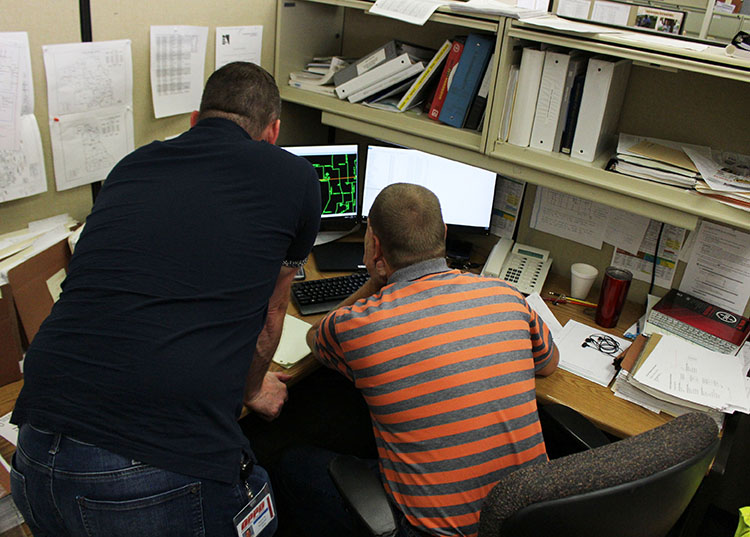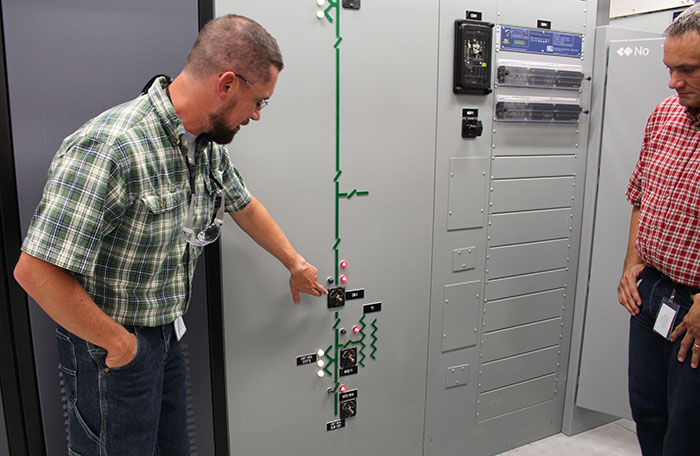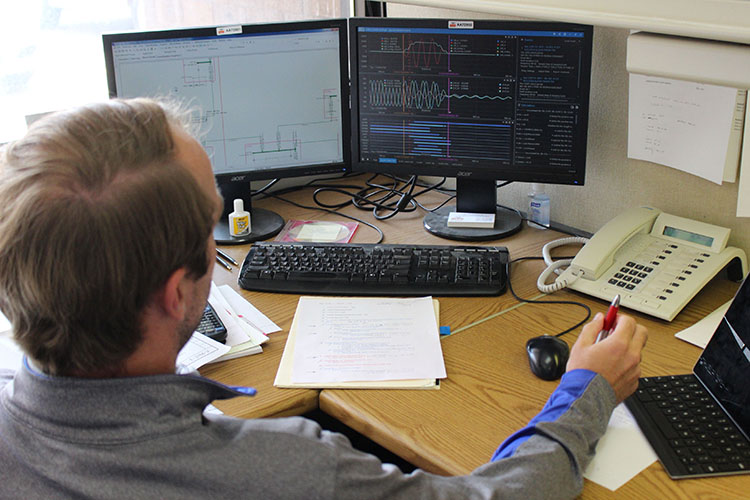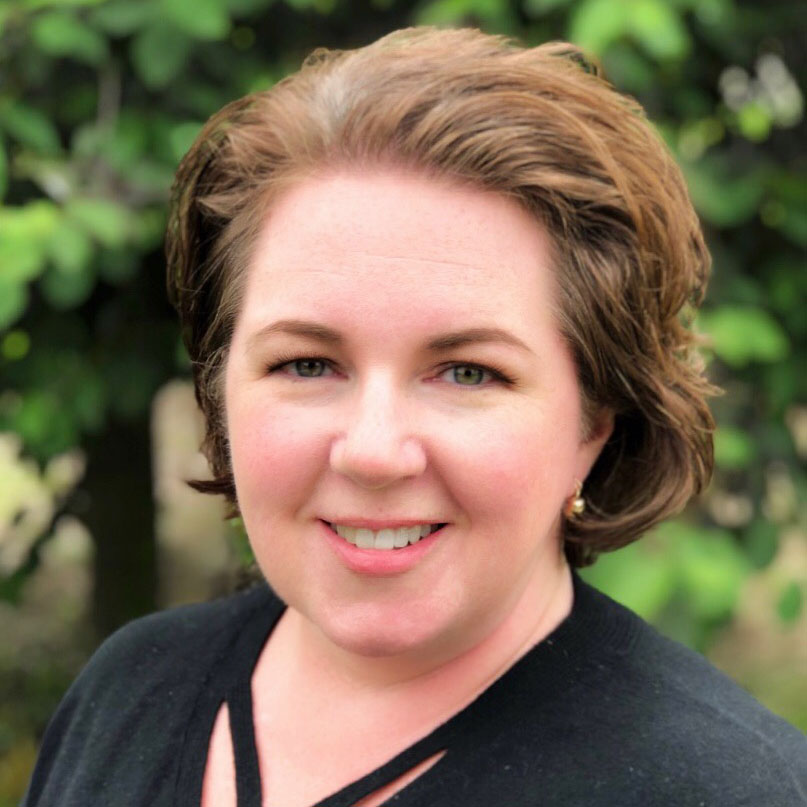Group performs complex calculations in crunch time

Imagine looking at lines of complicated calculations and having to pinpoint a single problem. Imagine operations personnel waiting on your work – and depending on its accuracy. Imagine hundreds of customers waiting for their power to be restored while you calculate.
High pressure, right? That’s common for the OPPD employees who work in Substation Protection and Automation, and it’s a responsibility they take seriously. Their work contributes to the continual flow of electricity from substations to homes reliably and efficiently.

Problem-solvers
The group works closely with Transmission Operations and Substation & System Protection to direct crews to the location of a problem area. But before substation or line crews can make a repair, often protection and automation must first figure out what happened and where.
It can involve some late nights and quick thinking.
“All of this happens in real time, quickly,” said Christopher Angland, manager, Protection and Automation Engineering. “Sometimes the lights are on at the (Elkhorn) center at night and that’s usually us.”
Power lines, poles and substations may look serene and still, but electricity moves fast, requiring the equipment within OPPD’s system to understand what’s going on at a rate 1/60th of a second. And requiring Protection and Automation to understand a problem and find a solution fast – and accurately.
Angland’s group includes electrical engineers skilled at working with 3-phase power systems. Beyond the nuts and bolts of the systems, the team also looks at the theory behind how it works, what happens when an event disrupts power and how best to respond.
The group also collaborates with two principal engineers who take more of a big-picture look at the system and look ahead to future issues that may arise. Together, it creates a relationship that incorporates a strategic component.

no typical day
A system disruption, equipment malfunction or outage can happen at any time. Protection and Automation has a diverse, critical mission that consists of both planned and unplanned outages on the transmission and distribution systems and work that impacts the utility’s production power plants. The group also ensures OPPD is up-to-date on compliance issues of the North American Electric Reliability Corporation (NERC).
“It’s challenging to keep up with not only changing technology, but changing compliance to address those changes,” Angland said.
Customer needs are changing as well, he said, with more commercial customers being served at a transmission level, such as the new Facebook data center. All of these factors have increased the pace inside the office located in the lower level of OPPD’s Elkhorn Service Center in west Omaha.
“Everything happens, everything’s changing and it’s all happening faster,” Angland said. “We have to be flexible, adaptive and perform at a high level all the time.”
When it comes to power plants, Protection and Automation provides Protection Engineering design support for the engineers working in generation. And they must be available to address unexpected problems with the plant’s protection equipment.
Working together, finding solutions
Did we mention electricity moves fast?
The continual flow of data between substations, power plants and OPPD’s control center never ends.
It is Protection and Automation’s job to ensure the configuration of the devices that deliver this crucial data are working. All of this data is eventually sent to the Energy Management computer system that monitors and models the electrical system. These models look at load flows and other functions. The data provided by the substation devices is critical to their accuracy.

Once they build system models, Protection and Automation must understand how each component will react to simulated events. This allows them to develop the best scheme to react to a situation.
Protection and Automation uses their own transmission and distribution system models to understand how each component will react to simulated events. This allows them to develop the best scheme to react to a situation.
“We want to find the quickest way to react because customers don’t want to see prolonged outages,” Angland said. “We want to restore them as quickly and safely as possible. That means we have to go through all scenarios real-time, right now.”
These models of the system allow them to anticipate problems so they have a head start should a situation arise. And the methods they use to run these models are always improving so they have better perspective into what happened.
“It’s fun stuff, but it can be daunting,” Angland explained. “There have been situations where a protection engineer has been the one person holding up reenergizing a large auto transformer… We have to have the courage to say, ‘we don’t know if that’s the right thing’ for our customers, our field crews and our assets. We are going to hold up the show until we know it’s the right thing to do.”
Low profile
Protection and Automation are not often OPPD employees customers regularly see restoring power in their neighborhood, but their work is often the first step to making repairs.
Angland said he hopes customers can appreciate that OPPD invests in a talented group of men and women whose job is to ensure the system is built to minimize the impact of any kind of event.

He said that working at OPPD allows the Protection and Automation engineers to dive into the details. They must account for every parameter they set. They need to understand what they did to come up with a solution and document their work. This can sometimes involve documents more than 20 pages in length.
Angland said the team is incorporating more and more technology solutions into their work to improve the process and expand the current tools they use to run simulations. In the years to come they hope to invest in more new technology that allows them to be faster.
The work changes rapidly, but it’s a challenge Angland said he is proud his team tackles with professionalism and passion.
“The fact that they keep up, and at such a high level is amazing. All I can do is support them the best I can – and try to keep up with them,” he said with a chuckle.


Laura King-Homan is the manager of Corporate Brand and Communication Operations, at Omaha Public Power District. She has nearly 20 years of print journalism and design experience, including the Omaha World-Herald.
View all posts by Laura King-Homan >







